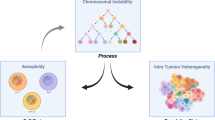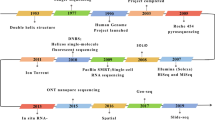Abstract
Owing to recent technical development of comprehensive genome-wide analysis such as next generation sequencing, deep biological insights of breast cancer have been revealed. Information of genomic mutations and rearrangements in patients’ tumors is indispensable to understand the mechanism in carcinogenesis, progression, metastasis, and resistance to systemic treatment of breast cancer. To date, comprehensive genomic analyses illustrate not only base substitution patterns and lists of driver mutations and key rearrangements, but also a manner of tumor evolution. Breast cancer genome is dynamically changing and evolving during cancer development course from non-invasive disease via invasive primary tumor to metastatic tumor, and during treatment exposure. The accumulation pattern of base substitution and genomic rearrangement looks gradual and punctuated, respectively, in analogy with contrasting theories for evolution manner of species, Darwin’s phyletic gradualism, and Eldredge and Gould’s “punctuated equilibrium”. Liquid biopsy is a non-invasive method to detect the genomic evolution of breast cancer. Genomic mutation patterns in circulating tumor cells and circulating cell-free tumor DNA represent those of tumors existing in patient body. Liquid biopsy methods are now under development for future application to clinical practice of cancer treatment. In this article, latest knowledge regarding breast cancer genome, especially in terms of ‘tumor evolution’, is summarized.

Similar content being viewed by others
References
Dexter DL, Kowalski HM, Blazar BA, Blazar A, Vogel R, Gloria H. Heterogeneity of tumor cells from a single mouse mammary tumor. Cancer Res. 1978;38:3174–81.
Heppner GH, Dexter DL, Denucci T. Heterogeneity in drug sensitivity among tumor cell subpopulations of a single mammary tumor. Cancer Res. 1978;38:3758–63.
Vindeløv LL, Spang-Thomsen M, Visfeldt J, Povlsen CO, Jensen GNN. Clonal evolution demonstrated by flow cytometric DNA analysis of a human colonic carcinoma grown in nude mice. Exp Cell Biol. 1982;50:216–21.
Kallioniemi A, Kallioniemi O, Sudar D, Rutovitz D, Gray JW, Waldman F, et al. Comparative genomic hybridization for molecular cytogenetic analysis of solid tumors. Science. 1992;258:818–21.
Solinas-toldo S, Lampel S, Stilgenbauer S, Nickolenko J, Benner A. Matrix-based comparative genomic hybridization : biochips to screen for genomic imbalances. Genes Chromosomes Cancer. 1997;407:399–407.
Nik-Zainal S, Van Loo P, Wedge DC, Alexandrov LB, Greenman CD, Lau KW, et al. The life history of 21 breast cancers. Cell. 2012;149:994–1007. http://www.pubmedcentral.nih.gov/articlerender.fcgi?artid=3428864&tool=pmcentrez&rendertype=abstract. Accessed 9 Jul 2014.
Shah SP, Roth A, Goya R, Oloumi A, Ha G, Zhao Y, et al. The clonal and mutational evolution spectrum of primary triple-negative breast cancers. Nature. 2012;486:395–9. http://www.pubmedcentral.nih.gov/articlerender.fcgi?artid=3863681&tool=pmcentrez&rendertype=abstract. Accessed 9 Jul 2014.
Navin N, Kendall J, Troge J, Andrews P, Rodgers L, McIndoo J, et al. Tumour evolution inferred by single-cell sequencing. Nature. 2011;472:90–4. http://www.ncbi.nlm.nih.gov/pubmed/21399628. Accessed 11 Jul 2014.
Czyż ZT, Hoffmann M, Schlimok G, Polzer B, Klein CA. Reliable single cell array CGH for clinical samples. PLoS One. 2014;9:e85907. http://www.pubmedcentral.nih.gov/articlerender.fcgi?artid=3897541&tool=pmcentrez&rendertype=abstract. Accessed 9 Oct 2014.
Wang Y, Waters J, Leung ML, Unruh A, Roh W, Shi X, et al. Clonal evolution in breast cancer revealed by single nucleus genome sequencing. Nature. 2014;512:155–60. http://www.nature.com/doifinder/10.1038/nature13600. Accessed 30 Jul 2014.
Stephens PJ, Greenman CD, Fu B, Yang F, Bignell GR, Mudie LJ, et al. Massive genomic rearrangement acquired in a single catastrophic event during cancer development. Cell. 2011;144:27–40. http://www.pubmedcentral.nih.gov/articlerender.fcgi?artid=3065307&tool=pmcentrez&rendertype=abstract. Accessed 10 Jul 2014.
Forment JV, Kaidi A, Jackson SP. Chromothripsis and cancer: causes and consequences of chromosome shattering. Nat Rev Cancer. 2012;12:663–70. http://www.ncbi.nlm.nih.gov/pubmed/22972457. Accessed 11 Jul 2014.
Baca SC, Prandi D, Lawrence MS, Mosquera JM, Romanel A, Drier Y, et al. Punctuated evolution of prostate cancer genomes. Cell. 2013;153:666–77. http://www.pubmedcentral.nih.gov/articlerender.fcgi?artid=3690918&tool=pmcentrez&rendertype=abstract. Accessed 9 Jul 2014.
Loeb LA. Human cancers express mutator phenotypes: origin, consequences and targeting. Nat. Rev. Cancer. 2011;11:450–7. http://www.pubmedcentral.nih.gov/articlerender.fcgi?artid=4007007&tool=pmcentrez&rendertype=abstract. Accessed 12 Jul 2014.
Harris RS. Molecular mechanism and clinical impact of APOBEC3B-catalyzed mutagenesis in breast cancer. Breast Cancer Res. 2015;17:1–10. http://breast-cancer-research.com/content/17/1/8.
Alexandrov LB, Nik-Zainal S, Wedge DC, Aparicio S a JR, Behjati S, Biankin AV, et al. Signatures of mutational processes in human cancer. Nature. 2013;500:415–21. http://www.pubmedcentral.nih.gov/articlerender.fcgi?artid=3776390&tool=pmcentrez&rendertype=abstract.
Hernandez L, Wilkerson P. Genomic and mutational profiling of ductal carcinomas in situ and matched adjacent invasive breast cancers reveals intra‐tumour genetic heterogeneity and clonal. J Pathol. 2012;227:42–52. http://onlinelibrary.wiley.com/doi/10.1002/path.3990/full. Accessed 9 Oct 2014.
Miron A, Varadi M, Carrasco D, Li H, Luongo L, Kim HJ, et al. PIK3CA mutations in in situ and invasive breast carcinomas. Cancer Res. 2010;70:5674–8. http://www.pubmedcentral.nih.gov/articlerender.fcgi?artid=2905503&tool=pmcentrez&rendertype=abstract. Accessed 9 Oct 2014.
Zhou W, Muggerud A a, Vu P, Due EU, Sørlie T, Børresen-Dale A-L, et al. Full sequencing of TP53 identifies identical mutations within in situ and invasive components in breast cancer suggesting clonal evolution. Mol. Oncol. 2009;3:214–9. http://www.ncbi.nlm.nih.gov/pubmed/19403344. Accessed 9 Oct 2014.
Ding L, Ellis MJ, Li S, Larson DE, Chen K, Wallis JW, et al. Genome remodelling in a basal-like breast cancer metastasis and xenograft. Nature. 2010;464:999–1005. http://www.pubmedcentral.nih.gov/articlerender.fcgi?artid=2872544&tool=pmcentrez&rendertype=abstract. Accessed 25 Jul 2014.
Yachida S, Jones S, Bozic I, Antal T, Leary R, Fu B, et al. Distant metastasis occurs late during the genetic evolution of pancreatic cancer. Nature. 2010;467:1114–7. http://www.pubmedcentral.nih.gov/articlerender.fcgi?artid=3148940&tool=pmcentrez&rendertype=abstract. Accessed 9 Jul 2014.
Ding L, Ley TJ, Larson DE, Miller C a, Koboldt DC, Welch JS, et al. Clonal evolution in relapsed acute myeloid leukaemia revealed by whole-genome sequencing. Nature. 2012;481:506–10. http://www.pubmedcentral.nih.gov/articlerender.fcgi?artid=3267864&tool=pmcentrez&rendertype=abstract. Accessed 14 Jul 2014.
Gerlinger M, Rowan A, Horswell S, Larkin J, Endesfelder D, Gronroos E, et al. Intratumor heterogeneity and branched evolution revealed by multiregion sequencing. N Engl J Med. 2012;366:883–92.
Comen E, Norton L, Massagué J. Clinical implications of cancer self-seeding. Nat Rev Clin Oncol. 2011;8:369–77. http://www.ncbi.nlm.nih.gov/pubmed/21522121. Accessed 9 Oct 2014.
Yu M, Bardia A, Wittner BS, Stott SL, Smas ME, Ting DT, et al. Circulating breast tumor cells exhibit dynamic changes in epithelial and mesenchymal composition. Science. 2013;339:580–4. http://www.pubmedcentral.nih.gov/articlerender.fcgi?artid=3760262&tool=pmcentrez&rendertype=abstract. Accessed 10 Jul 2014.
Møller EK, Kumar P, Voet T, Peterson A, Van Loo P, Mathiesen RR, et al. Next-generation sequencing of disseminated tumor cells. Front Oncol. 2013;3:320. http://www.pubmedcentral.nih.gov/articlerender.fcgi?artid=3876274&tool=pmcentrez&rendertype=abstract. Accessed 6 Oct 2014.
Leon S, Shapiro B, Sklaroff D, Yaros M. Free DNA in the serum of cancer patients and the effect of therapy. Cancer Res. 1977;37:646–50. http://cancerres.aacrjournals.org/content/37/3/646.short. Accessed 9 Oct 2014.
Murtaza M, Dawson S-J, Tsui DWY, Gale D, Forshew T, Piskorz AM, et al. Non-invasive analysis of acquired resistance to cancer therapy by sequencing of plasma DNA. Nature. Nature Publishing Group; 2013;497:108–12. http://www.ncbi.nlm.nih.gov/pubmed/23563269. Accessed 9 Jul 2014.
Leary RJ, Sausen M, Kinde I, Papadopoulos N, Carpten JD, Craig D, et al. Detection of chromosomal alterations in the circulation of cancer patients with whole-genome sequencing. Sci Transl Med. 2012;4:162ra154. http://www.pubmedcentral.nih.gov/articlerender.fcgi?artid=3641759&tool=pmcentrez&rendertype=abstract. Accessed 11 Jul 2014.
Higgins MJ, Jelovac D, Barnathan E, Blair B, Slater S, Powers P, et al. Detection of tumor PIK3CA status in metastatic breast cancer using peripheral blood. Clin Cancer Res. 2012;18:3462–9. http://www.pubmedcentral.nih.gov/articlerender.fcgi?artid=3533370&tool=pmcentrez&rendertype=abstract. Accessed 22 Sep 2014.
Al-Hajj M, Wicha MS, Benito-Hernandez A, Morrison SJ, Clarke MF. Prospective identification of tumorigenic breast cancer cells. Proc Natl Acad Sci USA. 2003;100:3983–8.
Ginestier C, Hur MH, Charafe-Jauffret E, Monville F, Dutcher J, Brown M, et al. ALDH1 is a marker of normal and malignant human mammary stem cells and a predictor of poor clinical outcome. Cell Stem Cell. 2007;1:555–67. http://www.pubmedcentral.nih.gov/articlerender.fcgi?artid=2423808&tool=pmcentrez&rendertype=abstract. Accessed 13 Jul 2014.
Park SY, Gönen M, Kim HJ, Michor F, Polyak K. Cellular and genetic diversity in the progression of in situ human breast carcinomas to an invasive phenotype. J Clin Invest. 2010;120:636–44.
Balko JM, Giltnane JM, Wang K, Schwarz LJ, Young CD, Cook RS, et al. Molecular profiling of the residual disease of triple-negative breast cancers after neoadjuvant chemotherapy identifies actionable therapeutic targets. Cancer Discov. 2014;4:232–45. http://www.pubmedcentral.nih.gov/articlerender.fcgi?artid=3946308&tool=pmcentrez&rendertype=abstract. Accessed 24 Sep 2014.
Dawson S-J, Tsui DWY, Murtaza M, Biggs H, Rueda OM, Chin S-F, et al. Analysis of circulating tumor DNA to monitor metastatic breast cancer. N Engl J Med. 2013;368:1199–209. http://www.ncbi.nlm.nih.gov/pubmed/23484797. Accessed 9 Jul 2014.
Conflict of interest
Fumiaki Sato, Shigehira Saji, and Masakazu Toi have no conflict of interest.
Author information
Authors and Affiliations
Corresponding author
About this article
Cite this article
Sato, F., Saji, S. & Toi, M. Genomic tumor evolution of breast cancer. Breast Cancer 23, 4–11 (2016). https://doi.org/10.1007/s12282-015-0617-8
Received:
Accepted:
Published:
Issue Date:
DOI: https://doi.org/10.1007/s12282-015-0617-8




